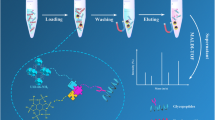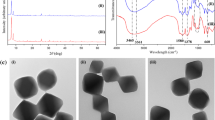Abstract
Development of novel materials for enrichment of glycopeptides is the key to a comprehensive analysis of the glycoproteome, which is closely related to several major diseases and biomarker findings. We synthesized phenylboronic acid (PBA) bound to SiO2 microspheres by a thiol–ene click chemistry method (this material was denoted as click PBA) and used it to separate cis-diol-containing molecules and enrich glycopeptides in hydrophilic interaction chromatography mode. Successful preparation of click PBA was confirmed by elemental analysis, X-ray photoelectron spectroscopy, N2 adsorption–desorption isotherms, and high-resolution scanning electron microscopy. Click PBA showed stronger retention towards glycopeptides under alkaline, higher content of organic solution conditions than under acidic, higher content of organic solution or alkaline aqueous solution conditions. Click PBA exhibited high selectivity for both neutral and acidic glycopeptides, which could resist interference from 100 molar fold of bovine serum albumin digests. The high enrichment efficiency can be ascribed to the synergetic effects of affinity interaction and hydrophilic interaction. The application of click PBA to 1 μL human serum resulted in the identification of 101 unique glycosylation sites from 71 glycoproteins. Such material will facilitate comprehensive glycoproteome analysis.








Similar content being viewed by others
References
Yi W, Clark PM, Mason DE, Keenan MC, Hill C, Goddard III WA, et al. Phosphofructokinase 1 glycosylation regulates cell growth and metabolism. Science. 2012;337(6097):975–80.
Perez C, Gerber S, Boilevin J, Bucher M, Darbre T, Aebi M, et al. Structure and mechanism of an active lipid-linked oligosaccharide flippase. Nature. 2015;524(7566):433.
Croci DO, Cerliani JP, Dalotto-Moreno T, Mendez-Huergo SP, Mascanfroni ID, Dergan-Dylon S, et al. Glycosylation-dependent lectin-receptor interactions preserve angiogenesis in anti-VEGF refractory tumors. Cell. 2014;156(4):744–58.
Ahn YH, Shin PM, Kim Y-S, Oh NR, Ji ES, Kim KH, et al. Quantitative analysis of aberrant protein glycosylation in liver cancer plasma by AAL-enrichment and MRM mass spectrometry. Analyst. 2013;138(21):6454–62.
Boersema PJ, Geiger T, Wisniewski JR, Mann M. Quantification of the N-glycosylated secretome by super-SILAC during breast cancer progression and in human blood samples. Mol Cel Proteomics. 2013;12(1):158–71.
Anderson NL, Anderson NG. The human plasma proteome - history, character, and diagnostic prospects. Mol Cel Proteomics. 2002;1(11):845–67.
Lu Y, Bie ZJ, Liu YC, Liu Z. Fine-tuning the specificity of boronate affinity monoliths toward glycoproteins through pH manipulation. Analyst. 2013;138(1):290–8.
Nilsson J, Rüetschi U, Halim A, Hesse C, Carlsohn E, Brinkmalm G, et al. Enrichment of glycopeptides for glycan structure and attachment site identification. Nat Methods. 2009;6(11):809–11.
Wu SJ, Li XL, Zhang FF, Jiang G, Liang XM, Yang BC. An arginine-functionalized stationary phase for hydrophilic interaction liquid chromatography. Analyst. 2015;140(12):3921–4.
Yu L, Li X, Guo Z, Zhang X, Liang X. Hydrophilic interaction chromatography based enrichment of glycopeptides by using click maltose: a matrix with high selectivity and glycosylation heterogeneity coverage. Chem Eur J. 2009;15(46):12618–26.
Kuo CW, Wu IL, Hsiao HH, Khoo KH. Rapid glycopeptide enrichment and N-glycosylation site mapping strategies based on amine-functionalized magnetic nanoparticles. Anal Bioanal Chem. 2012;402(9):2765–76.
He XM, Zhu GT, Zhu YY, Chen X, Zhang Z, Wang ST, et al. Facile preparation of biocompatible sulfhydryl cotton fiber-based sorbents by "thiol ene" click chemistry for biological analysis. ACS Appl Mater Interfaces. 2014;6(20):17857–64.
Liu JX, Qu YY, Yang KG, Wu Q, Shan YC, Zhang LH, et al. Monodisperse boronate polymeric particles synthesized by a precipitation polymerization strategy: particle formation and glycoprotein response from the standpoint of the Flory-Huggins model. ACS Appl Mater Interfaces. 2014;6(3):2059–66.
Lin ZA, Wang J, Tan XQ, Sun LX, Yu RF, Yang HH, et al. Preparation of boronate-functionalized molecularly imprinted monolithic column with polydopamine coating for glycoprotein recognition and enrichment. J Chromatogr A. 2013;1319:141–7.
Yang F, Mao J, He XW, Chen LX, Zhang YK. Synthesis of boronate-silica hybrid affinity monolith via a one-pot process for specific capture of glycoproteins at neutral conditions. Anal Bioanal Chem. 2013;405(21):6639–48.
Li XL, Liu HL, Qing GY, Wang ST, Liang XM. Efficient enrichment of glycopeptides using phenylboronic acid polymer brush modified silica microspheres. J Mater Chem B. 2014;2(16):2276–81.
Shen AJ, Guo ZM, Yu L, Cao LW, Liang XM. A novel zwitterionic HILIC stationary phase based on "thiol-ene" click chemistry between cysteine and vinyl silica. Chem Commun. 2011;47(15):4550–2.
Cox J, Mann M. MaxQuant enables high peptide identification rates, individualized p.p.b.-range mass accuracies and proteome-wide protein quantification. Nat Biotechnol. 2008;26(12):1367–72.
Zheng JN, Xiao Y, Wang L, Lin Z, Yang HH, Zhang L, et al. Click synthesis of glucose-functionalized hydrophilic magnetic mesoporous nanoparticles for highly selective, enrichment of glycopeptides and glycans. J Chromatogr A. 2014;1358:29–38.
Ashburner M, Ball CA, Blake JA, Botstein D, Butler H, Cherry JM, et al. Gene Ontology: tool for the unification of biology. Nat Genet. 2000;25(1):25–9.
Acknowledgments
We thank the National Natural Science Foundation of China (81472487).
Author information
Authors and Affiliations
Corresponding author
Ethics declarations
Conflict of interest
The authors declare that they have no conflict of interest.
Additional information
Published in the topical collection Glycomics, Glycoproteomics and Allied Topics with guest editors Yehia Mechref and David Muddiman.
Electronic supplementary material
Below is the link to the electronic supplementary material.
ESM 1
(PDF 1003 kb)
Rights and permissions
About this article
Cite this article
Chen, J., Li, X., Feng, M. et al. Novel boronate material affords efficient enrichment of glycopeptides by synergized hydrophilic and affinity interactions. Anal Bioanal Chem 409, 519–528 (2017). https://doi.org/10.1007/s00216-016-0044-5
Received:
Revised:
Accepted:
Published:
Issue Date:
DOI: https://doi.org/10.1007/s00216-016-0044-5




